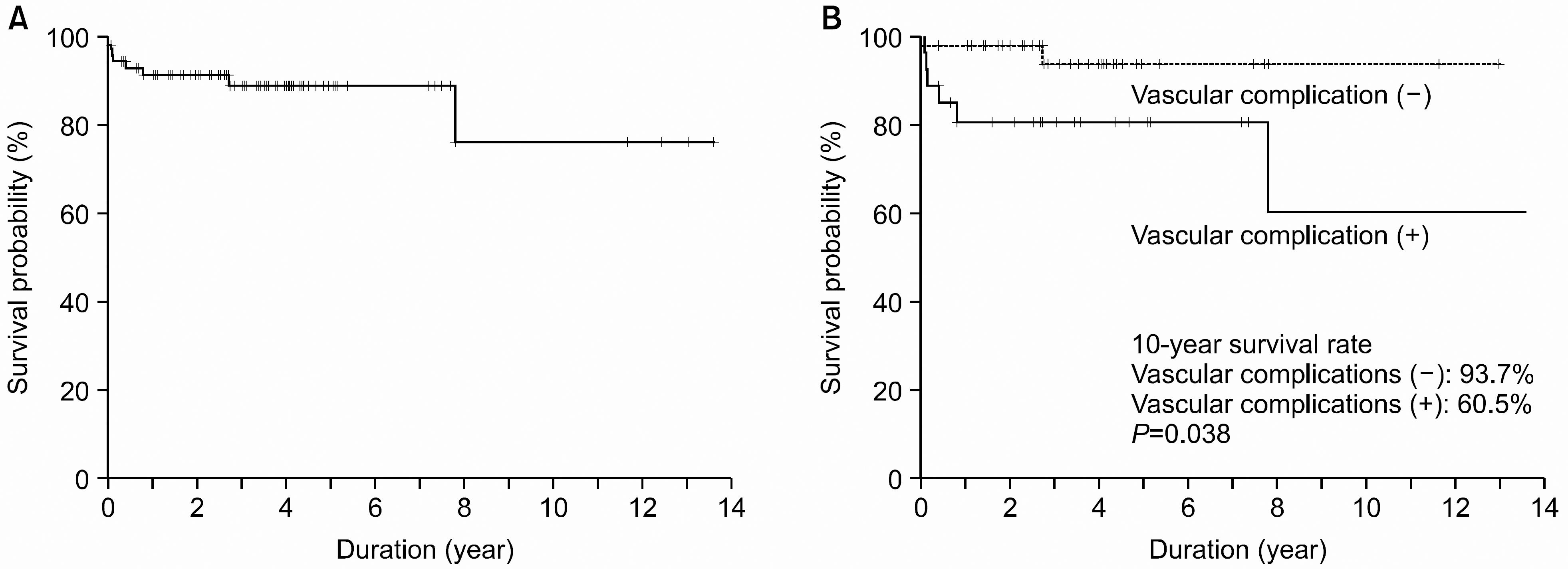Abstract
Background:
Essential thrombocythemia (ET) has a chronic course, but its main clinical features are thrombosis and hemorrhage. We evaluated the clinical features, including the vascular complications in patients with ET, during the disease courses and we determined the predictable risk factors for major vascular complications.
Methods:
From 1991 to 2004, the medical records for 69 patients with ET were retrospectively reviewed for evaluating the clinical features, including the vascular complications, and the predictable risk factors for major vascular complications were analyzed.
Results:
Major vascular thrombotic and hemorrhagic complications were observed in 16 patients (23.2%) and 6 patients (8.7%) at the time of diagnosis, and in 13 (18.8%) and 9 patients (13.0%) during follow-up. The incidence of major vascular thromboses in the older group (age >60 years) was higher than that in the younger group (≤60 years) (34.2% vs 9.7%, respectively, P=0.016) at the time of diagnosis. During follow-up, the major vascular thrombosis risk was increased in patients with a previous thrombosis history (37.5% vs 13.2%, respectively, P=0.029) and in patients with 2 or more combined cardiovascular risk factors (44.4% vs 15.0%, respectively, P=0.035). The probability of 10-year survival in patients with thrombo-hemorrhagic complications during the disease course was lower than that in patients without complication (60.5% vs 93.7%, respectively, P=0.046).
Conclusion:
Advanced age, a previous thrombosis history and the combined cardiovascular risk factors were the risk factors for major vascular thrombosis in patients with ET. Prevention of thrombo-hemorrhagic complications is the most important therapeutic goal. Treatment strategies according to risk factors ought to be prospectively investigated.
REFERENCES
2). Rozman C., Giralt M., Feliu E., Rubio D., Cortés MT. Life expectancy of patients with chronic nonleukemic myeloproliferative disorders. Cancer. 1991. 67:2658–63.

3). Murphy S., Peterson P., Iland H., Laszlo J. Experience of the Polycythemia Vera Study Group with essential thrombocythemia: a final report on diagnostic criteria, survival, and leukemic transition by treatment. Semin Hematol. 1997. 34:29–39.
4). Vardiman JW., Harris NL., Brunning RD. The World Health Organization (WHO) classification of the myeloid neoplasms. Blood. 2002. 100:2292–302.

5). Elliott MA., Tefferi A. Thrombosis and hemorrhage in polycythaemia vera and essential thrombocythaemia. Br J Haematol. 2004. 128:275–90.
6). Thiele J., Kvasnicka HM. Chronic myeloproliferative disorders with thrombocythemia: a comparative study of two classification systems (PVSG, WHO) on 839 patients. Ann Hematol. 2003. 82:148–52.

7). Baxter EJ., Scott LM., Campbell PJ, et al. Acquired mutation of the tyrosine kinase JAK2 in human myeloproliferative disorders. Lancet. 2005. 365:1054–61.

8). Campbell PJ., Green AR. Management of polycythemia vera and essential thrombocythemia hematology. (Am Soc Hematol Educ Program). 2005. 201–8.
9). Cortelazzo S., Viero P., Finazzi G., D'Emilio A., Rodeghiero F., Barbui T. Incidence and risk factors for thrombotic complications in a historical cohort of 100 patients with essential thrombocythemia. J Clin Oncol. 1990. 8:556–62.

10). Besses C., Cervantes F., Pereira A, et al. Major vascular complications in essential thrombocythaemia: a study of the predictive factors in a series of 148 patients. Leukemia. 1999. 13:150–4.
11). Cho SJ., Shin DG., Lee KH, et al. Essential thrombocythemia: vascular complications and cardiovascular risk factors. Korean J Hematol. 1999. 34:608–13.
12). Jantunen R., Juvonen E., Ikkala E., Oksanen K., Anttila P., Ruutu T. The predictive value of vascular risk factors and gender for the development of thrombotic complications in essential thrombocythemia. Ann Hematol. 2001. 80:74–8.

13). Shih LY., Lin TL., Lai CL, et al. Predictive values of X-chromosome inactivation patterns and clinicohematologic parameters for vascular complications in female patients with essential thrombocythemia. Blood. 2002. 100:1596–601.

14). Cortelazzo S., Finazzi G., Ruggeri M, et al. Hydroxyurea for patients with essential thrombocythemia and a high risk of thrombosis. N Engl J Med. 1995. 332:1132–36.

15). Finazzi G., Budde U., Michiels J. Bleeding time and platelet function in essential thrombocythemia and other myeloproliferative syndromes. Leuk Lymphoma. 1996. 22:71–8.

16). Regev A., Stark P., Blikstein D., Lahav M. Thrombotic complications in essential thrombocythemia with relatively low platelet counts. Am J Hematol. 1997. 56:168–72.

17). Landolfi R., Marchioli R., Patrono C. Mechanisms of bleeding and thrombosis in myeloproliferative disorders. Thromb Haemost. 1997. 78:617–21.

18). Raszeja-Specht A., Skibowska A., Bieniaszewska M., Szutowicz A. Relationships between thrombohemor-rhagic complications and platelet function in patients with essential thrombocythaemia. Am J Hematol. 2001. 68:32–6.

19). Johansson P., Ricksten A., Wennstrom L., Palmqvist L., Kutti J., Andreasson B. Increased risk for vascular complications in PRV-1 positive patients with essential thrombocythaemia. Br J Haematol. 2003. 123:513–6.

20). Sterkers Y., Preudhomme C., Lai JL, et al. Acute myeloid leukemia and myelodysplastic syndomes following essential thrombocythemia treated with hydroxyurea: high proportion of cases with 17p deletion. Blood. 1998. 91:616–22.
21). Gugliotta L., Marchioli R., Fiacchini M. Epidemiological, diagnostic, therapeutic and prognostic aspects of essential thrombocythaemia in a retrospective study of he GIMMC group in two thousand patients. Blood. 1997. 90:348a, abstract. 1523.
22). Storen EC., Tefferi A. Long-term use of anagrelide in young patients with essential thrombocythemia. Blood. 2001. 87:863–6.

23). Mazzucconi MG., Redi R., Bernasconi S, et al. A long-term study of young patients with essential thrombocythemia treated with anagrelide. Haematolo-gica. 2004. 89:1306–13.
Fig. 1
Survival curves of essential thromcythemia patients. (A) Overall survival of all patients, (B) survival according to major vascular thrombo-hemorrhagic complication.

Table 1.
Patient characteristics
Table 2.
Thrombotic and hemorrhagic vascular complications in essential thrombocythemia patients
Table 3.
Subgroup analysis of the incidence of major thrombotic complications at the time of diagnosis in essential thrombocythemia patients
Table 4.
Subgroup analysis of the incidence of major thrombotic complications during the follow-up in essential thrombocythem patients




 PDF
PDF ePub
ePub Citation
Citation Print
Print


 XML Download
XML Download